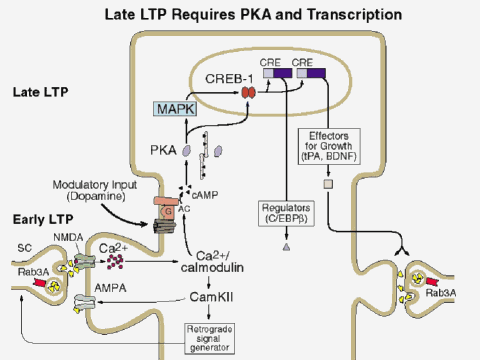 |
A schematic model
of the molecular events contributing to the early and late phase of LTP in
the Schaffer collateral pathway. A single train of action potentials
initiates early LTP by activating NMDA receptors, leading to Ca2+ influx
into the postsynaptic cell, and to the recruitment of a set of second
messenger kinases including the calcium calmodulin-dependent protein kinase
which phosphorylates existing AMPA receptors and also leads to the insertion
of new receptors. There is also thought to be a retrograde signal that
diffuses from the postsynaptic cell to the presynaptic terminals to enhance
transmitter release. With four repeated trains, the Ca2+ influx also
recruits adenylys cyclase, which activates the cAMP-dependent protein kinase
(PKA) and MAPK. These kinases translocate to the nucleus where they
phosphorylate CREB and other transciption factors. CREB in turn activates
target genes that are thought to lead to structural changes. Mutations in
mice that block PKA or CREB reduce the late phase of LTP and compromise
long-term memory for space. The adenylyl cyclase can also by modulated by
the modulatory transmitter dopamine acting through D1/D5 receptors.
|
